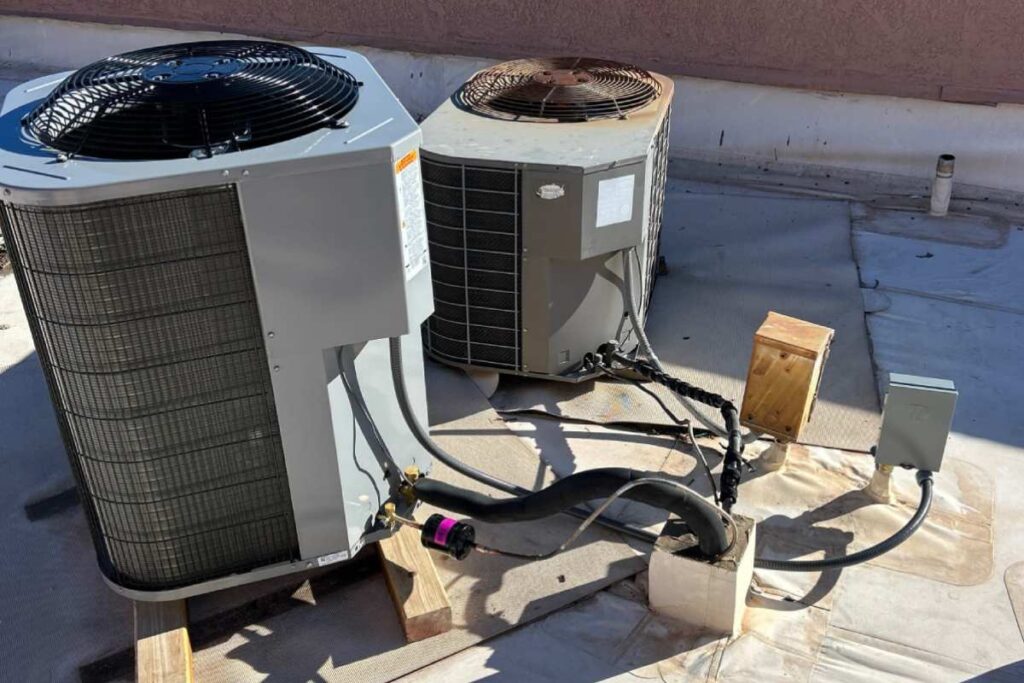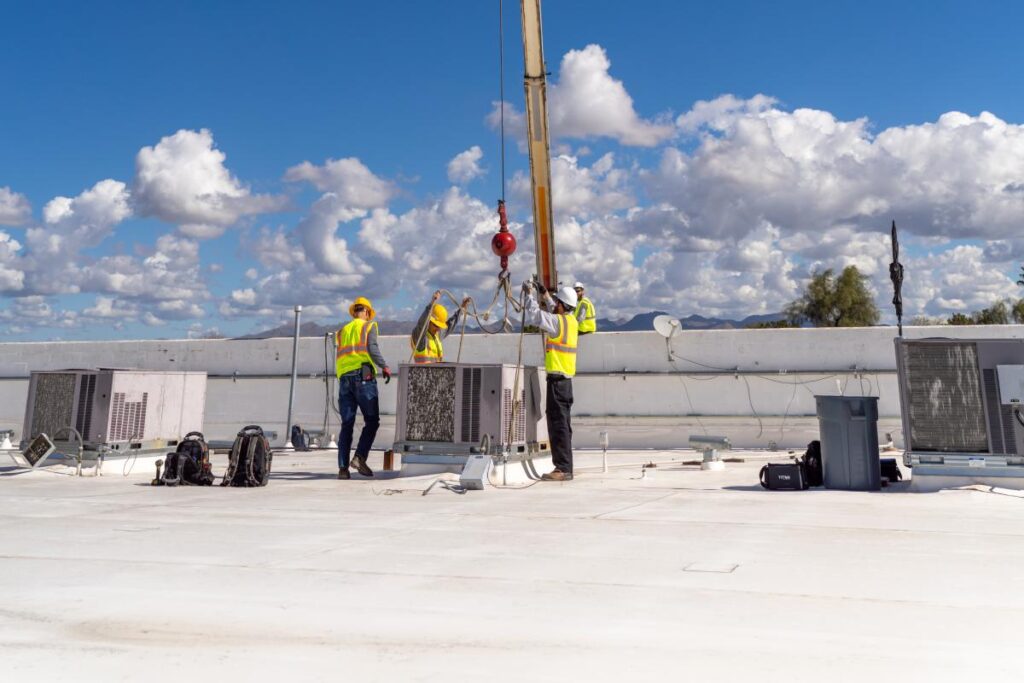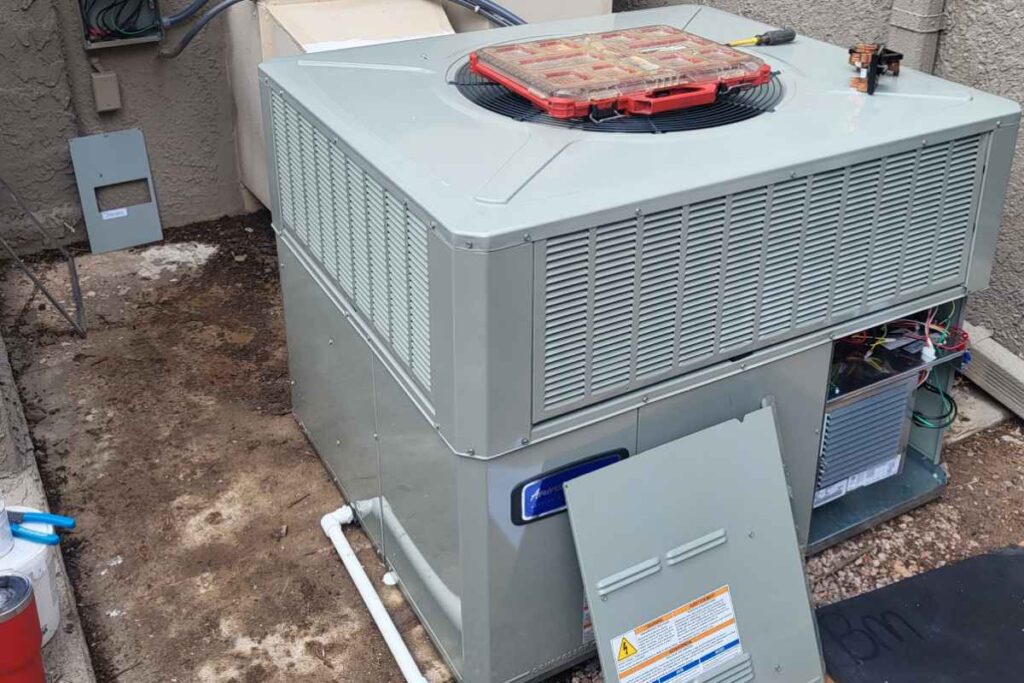
AC replacement might not always be the first thought on a homeowner’s mind, especially when weighed against other home improvement projects.
Yet, it stands out as a crucial investment for ensuring indoor comfort and efficiency. This significance places AC replacement in a category of its own, essential for those living in Arizona’s intense heat.
The landscape of AC replacement options is diverse, offering something for every need and preference. Central air conditioners, ductless mini-split systems, and various sizes measured in tons or BTUs highlight the range of choices available. Each type of AC unit, from the robust central systems to the adaptable mini-splits, brings its unique strengths to the table.
Single-unit options also stand out, providing a simpler yet effective solution for targeted cooling. Delving deeper, each AC system type not only offers distinct cooling capabilities but also comes with its own installation requirements, energy efficiency levels, and potential for home value enhancement. The subsequent sections will delve into these considerations in more detail, offering a comprehensive understanding of what makes AC replacement a pivotal decision for homeowners.
This exploration aims to equip you with the knowledge to make an informed choice that aligns with your cooling needs, budget, and long-term comfort objectives.
Table of Contents
What is AC replacement?
AC replacement is the process of removing an old or malfunctioning air conditioning unit and installing a new one. This step is crucial, especially in areas where the heat can be relentless. It’s about more than just upgrading to a new model; it’s about ensuring your home remains a comfortable refuge from the extreme temperatures outside.
Whether your current system is inefficient, aging, or frequently breaking down, replacing your AC can lead to significant improvements in your home’s comfort, energy efficiency, and even its overall value. With advancements in technology, newer AC models offer better efficiency, lower energy costs, and superior cooling capabilities.
Thus, AC replacement emerges as a strategically beneficial decision for homeowners aiming to maintain an optimal living environment amidst challenging climates. For reliable emergency AC repair, quick responses during unexpected system failures are essential.
Factors affecting AC replacement cost
The cost of AC replacement is shaped by several key factors, making the price of each installation project unique. The type of AC unit is a significant determinant, with options like central air conditioners and ductless mini-split systems presenting different cost implications. The size of the AC unit, measured in tons or BTUs, is crucial as well; the unit must be properly sized to your home to ensure efficient operation and optimal comfort.
Installation complexity further influences the price, where considerations such as ductwork modification and the accessibility of the installation site can lead to variations in cost. Understanding these factors is vital for homeowners to effectively navigate the AC replacement process, enabling them to make informed choices that best suit their needs and financial plans. It’s also important to be aware of the reasons your air conditioner isn’t cooling, to take preventative measures to maintain efficiency.

Type of AC unit
The type of AC unit significantly influences the overall cost of replacement. Choices range from central air conditioners, designed for efficient cooling of large spaces through a ducted system, to ductless mini-split systems that offer a more flexible, ductless solution for individual rooms or spaces without existing ductwork. Finding expert air conditioning repair services can also ensure your system remains in peak condition.
Central air conditioners
Central air conditioners are the go-to for comprehensive home cooling, utilizing a network of ducts to distribute cool air. The cost is impacted by both the capacity of the unit and the complexity or condition of the home’s existing ductwork system.
Ductless mini-split systems
Ductless mini-split systems stand out for their ability to provide targeted cooling without the need for an extensive duct system. They are particularly cost-effective for cooling smaller areas, additions, or homes where traditional ducted systems are not feasible.
Size of the AC unit
The size of the AC unit, whether measured in tons or BTUs (British Thermal Units), is a critical factor in determining cost. An improperly sized unit—either too small or too large—can lead to inefficiency, increased energy costs, and discomfort.
Installation complexity
The installation complexity can vary widely, influencing labor and overall costs. This complexity can be affected by the need for ductwork modification or the accessibility of the installation site, with more complicated installations requiring additional time and resources.
Ductwork modification needed
Ductwork modification can add a significant amount to the cost of AC replacement. Whether it’s adjusting the size, sealing leaks, or installing new duct sections, these modifications require additional labor and materials.
Accessibility of installation site
The accessibility of the installation site directly impacts the cost. Sites that are easy to access can lead to lower labor costs, while challenging locations may necessitate special equipment or extra labor, increasing the overall expense. To address heating needs, affordable heating repair services can be crucial for maintaining year-round comfort.
Average cost of AC replacement
Homeowners can anticipate the average cost of AC replacement to range from $6,000 to $25,000+. This wide range reflects the various factors that can influence the final price, including the type of AC unit, size, and installation complexity.
Whether it’s the straightforward replacement of a central air conditioner or the installation of a ductless mini-split system, each scenario carries its own set of costs.
Additional considerations like ductwork modifications and the accessibility of the installation site further contribute to the variability in pricing. Given the critical role of air conditioning in ensuring comfort during intense heat, understanding these costs is essential for homeowners. This knowledge enables effective budgeting and decision-making, ensuring that investments in AC replacement yield both immediate comfort and long-term savings.
Ranges from $6,000 to $25,000+
The cost of AC replacement typically ranges from $6,000 to $25,000+.
This broad spectrum reflects the diverse array of homeowner needs and preferences, encompassing everything from the type of AC unit chosen to its size, and the particulars of the installation process. Key factors that can influence the final price within this range include the installation complexity, any necessary ductwork modifications, and the accessibility of the installation site.
This range highlights the importance of a tailored approach to understanding the unique aspects of your AC replacement project, ensuring you can accurately budget and prepare for this essential home improvement endeavor. For more personalized advice, phone our support.
How to get an accurate estimate for AC replacement
Obtaining an accurate estimate for AC replacement begins with contacting local air conditioning installers. It’s crucial to engage experts who can evaluate your specific situation and provide tailored advice and quotes. By requesting multiple quotes, you gain the advantage of comparing not just the costs but also the range of services offered, ensuring you find the best match for your needs and budget.
Additionally, paying attention to the energy efficiency ratings, particularly the SEER (Seasonal Energy Efficiency Ratio) rating, of potential new units is essential. These ratings can greatly influence both the initial investment and the long-term operational costs. Taking these steps ensures that homeowners can secure a comprehensive and precise estimate, empowering them to make well-informed decisions regarding their AC replacement.
Contacting local HVAC professionals
The foundational step towards an accurate AC replacement estimate is contacting local air conditioning installers. These experts bring a wealth of knowledge about the specific needs of your home, considering its size, the state of any existing system, and your unique cooling requirements. Their expertise is particularly valuable in regions like Arizona, where the local climate directly influences AC performance and selection criteria.
Requesting multiple quotes
Requesting multiple quotes is a critical strategy for homeowners. It enables a comprehensive comparison of not just the financial aspects but also the breadth of services offered by different providers. This approach ensures you find the best combination of quality service and competitive pricing, tailored to your specific needs.
Considering energy efficiency ratings
Considering energy efficiency ratings is a key factor in the AC replacement process. Units with higher efficiency ratings may come with a steeper initial price tag but can lead to considerable energy bill reductions in the long run. These ratings are instrumental in evaluating the long-term cost-effectiveness and environmental impact of your AC system.
SEER (Seasonal Energy Efficiency Ratio) rating
Focusing on the SEER (Seasonal Energy Efficiency Ratio) rating is essential when selecting a new AC unit. A higher SEER rating signifies greater efficiency, translating to lower energy usage and cost savings on utility bills. Opting for a unit with a superior SEER rating is especially advantageous in a demanding climate, ensuring your cooling system operates both effectively and economically.
Ways to save on AC replacement
To achieve savings on AC replacement, homeowners can explore a variety of strategies that offer immediate and long-term financial advantages. Rebates and incentives provided by federal, state, or local entities can substantially reduce the upfront costs associated with acquiring a new AC system.
Moreover, local utility companies often extend rebates to those who install energy-efficient models, further diminishing the initial expense. Choosing energy-efficient models with high SEER ratings not only makes you eligible for these rebates but also promises reduced energy expenditures in the future.
By adopting these approaches, homeowners can opt for a more economical and eco-friendly solution to their cooling needs, ensuring optimal comfort in a warm climate while maximizing their savings. For Tucson homeowners, variable speed AC options provide advanced efficiency and comfort.
Rebates and incentives
Leveraging rebates and incentives is a savvy approach for homeowners aiming to minimize the costs associated with AC replacement. These financial perks can dramatically reduce the upfront expenditure on new, more efficient air conditioning systems.
Federal tax credits
Taking advantage of federal tax credits can yield substantial savings for those who invest in energy-efficient AC systems. These credits directly decrease the amount of income tax you owe, offering a tangible reward for eco-friendly investments.
Local utility company rebates
Local utility company rebates present another opportunity for cost savings. Utilities often promote the use of energy-efficient appliances by providing rebates to homeowners who upgrade their AC units to models that consume less energy, thereby lowering the initial cost.
Choosing energy-efficient models
Opting for energy-efficient models not only benefits the planet but also your finances. These models typically have reduced operational costs, translating into considerable savings on utility bills throughout the lifespan of the AC unit.
Higher SEER ratings
Selecting AC units with higher SEER ratings is a wise decision for energy efficiency and financial savings. A higher SEER rating indicates superior efficiency, leading to less energy use and more savings on energy bills.
Importance of professional AC installation

Professional installation of your AC unit is paramount for a multitude of reasons. Foremost, it ensures the validity of the manufacturer’s warranty; many manufacturers stipulate that installation by certified professionals is required to maintain warranty protection.
Moreover, professional installation maximizes the efficiency and lifespan of your AC system. Experts are adept at navigating the complexities of optimal placement, airflow, and system configuration, which are critical for ensuring top performance and energy efficiency.
In the demanding Arizona climate, where reliance on AC systems is high, the significance of professional installation is magnified. It secures that your new AC unit is functioning at its best, offering comfort while optimizing energy expenditures.
Ensures warranty validity
A key advantage of professional AC installation is that it ensures the validity of the manufacturer’s warranty. Many AC manufacturers mandate that their systems be installed by licensed and certified professionals to maintain warranty protection. This stipulation safeguards your investment by guaranteeing that the installation adheres to the manufacturer’s strict specifications, potentially saving you from incurring costs on repairs or replacements that might not be covered otherwise.
Maximizes efficiency and lifespan
Furthermore, professional installation maximizes the efficiency and lifespan of your AC unit. Skilled technicians possess the necessary expertise to accurately size and install your system, optimizing its performance. The precision in installation impacts various factors, including airflow and system stress, which are crucial for ensuring your unit not only cools your home effectively but also operates as energy-efficiently as possible.
In the challenging Arizona heat, an efficiently functioning AC system is essential for maintaining comfort while keeping energy expenses manageable over the long haul.
Maintenance tips for your new AC unit

Ensuring the longevity and efficiency of your new AC unit hinges on consistent maintenance. A pivotal aspect of this maintenance is regular filter changes. Clean filters are essential for maintaining air quality and system efficiency, as accumulated dust and debris can impede airflow and diminish the system’s effectiveness.
This not only leads to increased energy consumption but can also shorten the lifespan of your unit. Moreover, annual professional inspections play a critical role in the health of your AC system. These inspections provide an opportunity to catch and rectify minor issues before they evolve into significant problems, thereby maintaining your system’s optimal performance.
By incorporating these maintenance practices, homeowners can ensure their AC units deliver enduring comfort, achieve lower energy costs, and enjoy an extended service life.
Regular filter changes
A cornerstone of maintaining your AC unit’s efficiency is regular filter changes. Clean filters are essential for sustaining high air quality and ensuring the system runs smoothly. When filters become clogged with dust and debris, they restrict airflow and compel the system to expend more energy to cool your home, which can lead to increased utility costs and a decrease in the lifespan of the unit.
It is recommended that homeowners check their filters monthly, particularly during periods of heavy usage, and replace them as necessary to maintain optimal performance.
Annual professional inspections
Annual professional inspections are vital for the health and longevity of your AC unit. These inspections, conducted by experienced technicians, involve a comprehensive examination of your system to detect and address any issues early on. This preventative measure can avert the escalation of small problems into larger, more expensive repairs, ensuring your system operates efficiently year-round.
For residents in Saddlebrooke, where reliance on air conditioning is high due to the warm climate, these yearly inspections are crucial for keeping your system in top condition and extending its service life. Additionally, finding reliable HVAC services in Saddlebrooke is essential for maintaining comfort.
